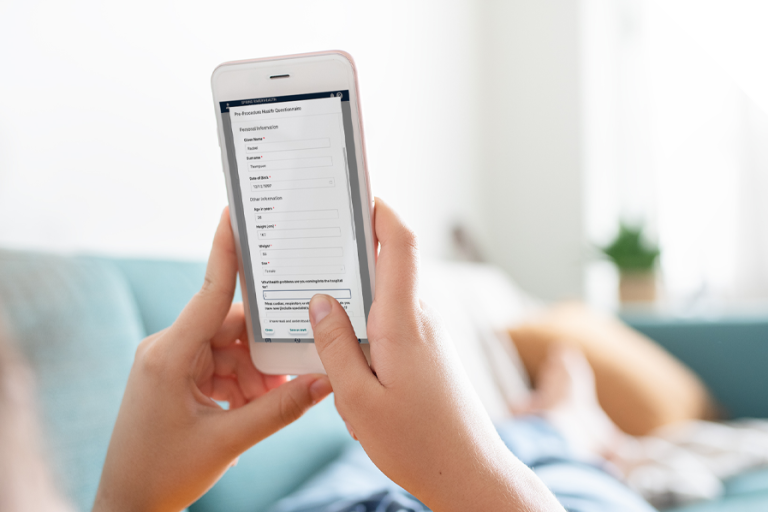Hospitals today face an ongoing challenge: how to manage high volumes of sensitive data quickly, accurately, and securely. Paper forms and manual processes often slow things down and introduce unnecessary risk. That’s where smart forms come in. They provide a secure, efficient, and patient-friendly way to streamline operations.
From front-desk intake to clinical documentation and internal administration, smart forms support better care delivery while reducing the burden on busy staff.
What Are Smart Forms?
In case you’re not familiar, smart forms are dynamic, digital forms used in collecting information. They adapt in real-time based on a user’s input. Unlike PDFs or paper-based documents, they’re interactive, responsive, and built to be completed on desktop, tablet, mobile or via kiosks on-site.
Five Faces’ Smart Forms are designed specifically for clinical and operational settings. Forms can be built from scratch or created using pre-configured templates, and staff can customise them using an intuitive drag-and-drop interface, with no coding or IT support required.
Forms are fully brandable with hospital or facility logos, and can include:
- Conditional logic-based fields that branch out depending on responses
- Digital signature capture
- Real-time submission tracking
- Secure, encrypted data storage
- Audit trails to support compliance
These forms can be used not just by patients, but also by staff for onboarding, shift handovers, incident reports, and more.

What Is the Concept of Form Management?
Form or document management refers to how a hospital creates, distributes, completes, tracks, and stores its forms while ensuring compliance and data integrity.
In paper-based systems, managing forms often involves multiple versions floating around on desks, printers, and inboxes. This makes updating details slow and hard to track. Errors are common, and valuable time is lost scanning or manually re-entering data.
Digital forms management solves these challenges by offering central control. With smart forms, teams can customise and update forms in real time, as well as route responses directly to the right team or system. It also allows for teams to monitor completion status and securely store the forms with role-based access.
This reduces admin time, improves accuracy, and ensures compliance with Australian privacy regulations.
Read more about The Importance of Customer Experience in the Health Industry.
How to Create a Smart Form (Using Five Faces)
Creating a smart form is simple. Most organisations begin by selecting a relevant template or starting from scratch.
From there, the process includes:
- Drag and drop your required fields like patient name, checkboxes, dropdowns, or text inputs.
- Apply logic rules so the form responds to user input (e.g. follow-up questions for certain symptoms).
- Add digital signatures and real-time tracking tools for audit compliance.
- Option to branding with your facility’s or hospital’s logos.
- Publish via QR code, secure link, or embed on a staff or patient portal.
- Track responses and route them automatically into your document management or clinical system.
The fact that smart forms are built to be used on desktop, tablet, or mobile means that they can be accessed with ease whenever required.

Why Hospitals Are Moving Away from Paper Forms
Paper-based forms are time-consuming, prone to error, and difficult to manage at scale. They require manual distribution, collection, and filing, all of which slows down service delivery and increases privacy risks.
Smart forms remove these friction points by offering a mobile-first experience that eliminates the need for printing or scanning. Built-in validation ensures that forms are completed correctly before submission, reducing errors and follow-ups. Once submitted, forms are securely routed to the appropriate teams or systems. This means no double-handling required.
Every interaction is logged, with full audit trails available to support privacy compliance and internal reporting. By replacing paper with secure, digital workflows, hospitals benefit from faster turnaround times, fewer duplicated tasks, and more accurate, actionable data.
Smart Forms vs. Other Digital Form Tools
While editable PDFs and simple online forms are common, they lack the flexibility, integration, and security required in hospital settings.
Generic form tools may not provide:
- Dynamic logic based on responses
- Digital signatures and submission tracking
- Role-based access and audit trails
- System integrations with EMR or document platforms
- Privacy safeguards required in clinical workflows
Smart forms like ours are purpose-built for healthcare. Whether you’re digitising patient admission, incident reporting, or internal approvals, they support complex workflows without sacrificing usability or compliance.

Supporting the Full Patient Journey and Beyond
Smart forms aren’t just for intake. They support every step of an organization‘s daily operations. Before an appointment, patients can complete intake forms online. During treatment, clinicians can fill out assessments and handover notes on a tablet. After discharge, follow-up forms or surveys can be automatically sent via SMS or email.
Forms can be filled out remotely or on-site, via tablet or kiosk, and submitted securely into your hospital’s workflow. For staff, that means more time focused on care and less time chasing paperwork.
Designed for Privacy and Security
Healthcare data must be protected at every stage and smart forms are built with this in mind. All submissions are encrypted and logged, with access limited by user roles. A full audit trail is maintained for every form, showing when it was created, viewed, modified, or submitted.
You can also configure retention rules to automatically delete forms after a set period. This access to secure health forms gives hospital administrators confidence in their compliance processes while reducing reliance on manual privacy protocols.
Getting Started: What to Expect When Implementing Smart Forms
Implementing smart forms is faster than you might think. At Five Faces, the process is guided, supportive, and focused on practical outcomes.
Here’s what to expect:
- Discovery: We begin with a short consultation to understand your workflows, risks, and goals.
- Customisation: We help you customise forms using your existing documents or pre-configured templates.
- Testing & Feedback: You’ll test forms across devices to ensure they work for all users.
- Deployment: Forms are launched via QR code, embedded link, or directly through your internal systems.
- Ongoing Support: We provide training, resources, and support to ensure your team is confident from day one.
No IT team? No problem. Our solution is designed for healthcare teams to manage themselves.
Smarter Forms, Better Care
Smart forms offer more than just a digital format of paperwork. They create a smarter, faster, and more secure experience for everyone. From patients filling in a form on a tablet to administrators tracking workflows across departments, smart forms are the best way to simplify document management.
If you’re ready to streamline hospital processes, improve data accuracy, and reduce admin strain, Five Faces can help. Contact us or explore our Smart Forms Solutions to see how our platform can support your digital transformation goals today.



